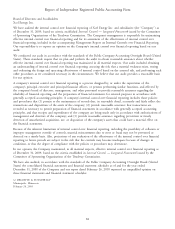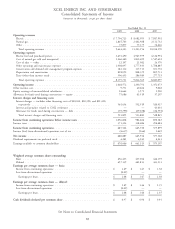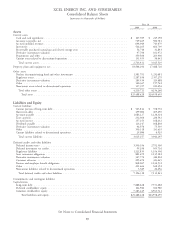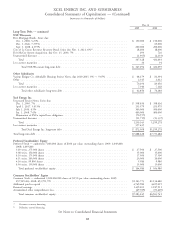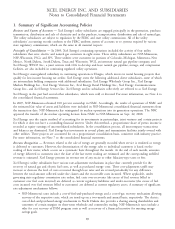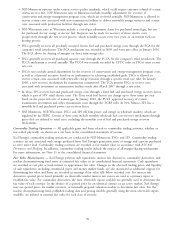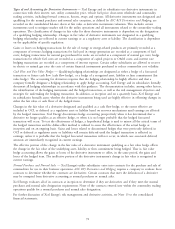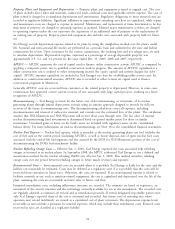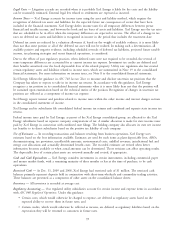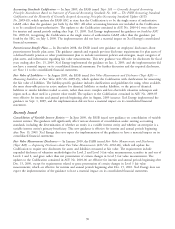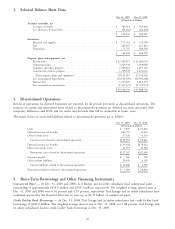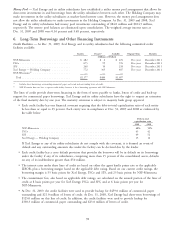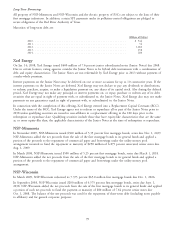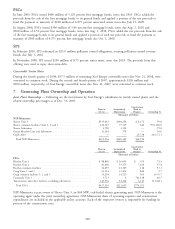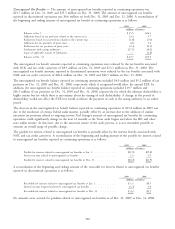Xcel Energy 2009 Annual Report Download - page 102
Download and view the complete annual report
Please find page 102 of the 2009 Xcel Energy annual report below. You can navigate through the pages in the report by either clicking on the pages listed below, or by using the keyword search tool below to find specific information within the annual report.Property, Plant and Equipment and Depreciation — Property, plant and equipment is stated at original cost. The cost
of plant includes direct labor and materials, contracted work, overhead costs and applicable interest expense. The cost of
plant retired is charged to accumulated depreciation and amortization. Regulatory obligations to incur removal costs are
recorded as regulatory liabilities. Significant additions or improvements extending asset lives are capitalized, while repairs
and maintenance costs are charged to expense as incurred. Maintenance and replacement of items determined to be less
than units of property are charged to operating expenses as incurred. Planned major maintenance activities are charged
to operating expense unless the cost represents the acquisition of an additional unit of property or the replacement of
an existing unit of property. Property, plant and equipment also includes costs associated with property held for future
use.
Xcel Energy records depreciation expense related to its plant by using the straight-line method over the plant’s useful
life. Actuarial and semi-actuarial life studies are performed on a periodic basis and submitted to the state and federal
commissions for review. Upon acceptance by the various commissions, the resulting lives and net salvage rates are used
to calculate depreciation. Depreciation expense, expressed as a percentage of average depreciable property, was
approximately 2.9, 3.2, and 3.2 percent for the years ended Dec. 31, 2009, 2008 and 2007, respectively.
AFUDC — AFUDC represents the cost of capital used to finance utility construction activity. AFUDC is computed by
applying a composite pretax rate to qualified construction work in progress. The amount of AFUDC capitalized as a
utility construction cost is credited to other nonoperating income (for equity capital) and interest charges (for debt
capital). AFUDC amounts capitalized are included in Xcel Energy’s rate base for establishing utility service rates. In
addition to construction-related amounts, AFUDC also is recorded to reflect returns on capital used to finance
conservation programs in Minnesota.
Generally, AFUDC costs are recovered from customers as the related property is depreciated. However, in some cases
commissions have approved a more current recovery of cost associated with large capital projects, resulting in a lower
recognition of AFUDC.
Decommissioning — Xcel Energy accounts for the future cost of decommissioning, or retirement, of its nuclear
generating plants through annual depreciation accruals using an annuity approach designed to provide for full rate
recovery of the future decommissioning costs. The decommissioning calculation covers all expenses, including
decontamination and removal of radioactive material, and extends over the estimated lives of the plants. The calculation
assumes that NSP-Minnesota and NSP-Wisconsin will recover those costs through rates. The fair value of external
nuclear decommissioning fund investments is determined based on quoted market prices for those or similar
investments. Unrealized gains or losses on the fund’s assets are included with regulatory assets on the consolidated
balance sheets. For more information on nuclear decommissioning, see Note 18 to the consolidated financial statements.
Nuclear Fuel Expense — Nuclear fuel expense, which is recorded as the nuclear generating plants use fuel, includes the
cost of fuel used in the current period (including AFUDC), as well as future disposal costs of spent nuclear fuel, costs
associated with the end-of-life fuel segments and fees assessed by the DOE for NSP-Minnesota’s portion of the cost of
decommissioning the DOE’s fuel-enrichment facility.
Nuclear Refueling Outage Costs — Effective Jan. 1, 2008, Xcel Energy expensed the costs associated with refueling
outages as incurred at its nuclear plants. In September 2008, the MPUC authorized Xcel Energy to use a deferral and
amortization method for the nuclear refueling O&M costs effective Jan. 1, 2008. This method amortizes refueling
outage costs over the period between refueling outages to better match revenues and expenses.
Environmental Costs — Environmental costs are recorded when it is probable Xcel Energy is liable for the costs and the
liability can reasonably be estimated. Costs may be deferred as a regulatory asset if it is probable that the costs will be
recovered from customers in future rates. Otherwise, the costs are expensed. If an environmental expense is related to
facilities currently in use, such as emission-control equipment, the cost is capitalized and depreciated over the life of the
plant, assuming the costs are recoverable in future rates or future cash flow.
Estimated remediation costs, excluding inflationary increases, are recorded. The estimates are based on experience, an
assessment of the current situation and the technology currently available for use in the remediation. The recorded costs
are regularly adjusted as estimates are revised and as remediation proceeds. If several designated responsible parties exist,
only Xcel Energy’s expected share of the cost is estimated and recorded. Any future costs of restoring sites where
operation may extend indefinitely are treated as a capitalized cost of plant retirement. The depreciation expense levels
recoverable in rates include a provision for removal expenses, which may include final remediation costs. Removal costs
recovered in rates are classified as a regulatory liability.
92


